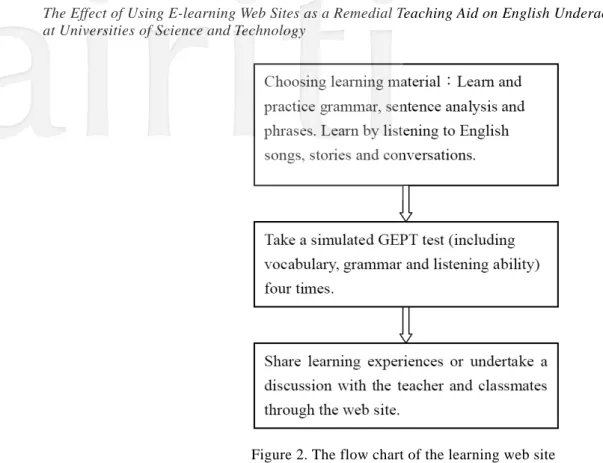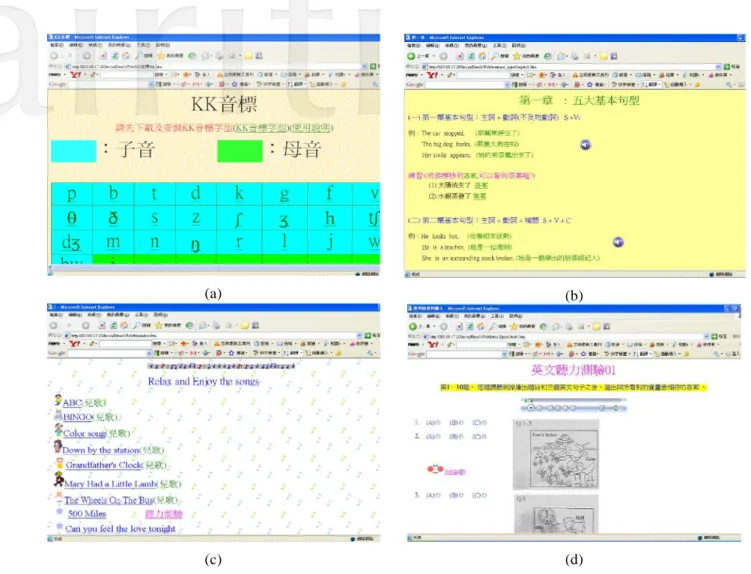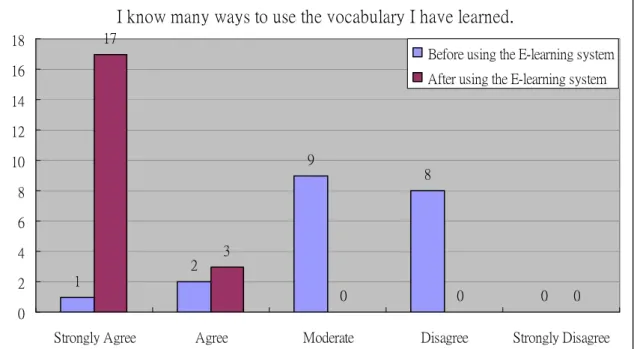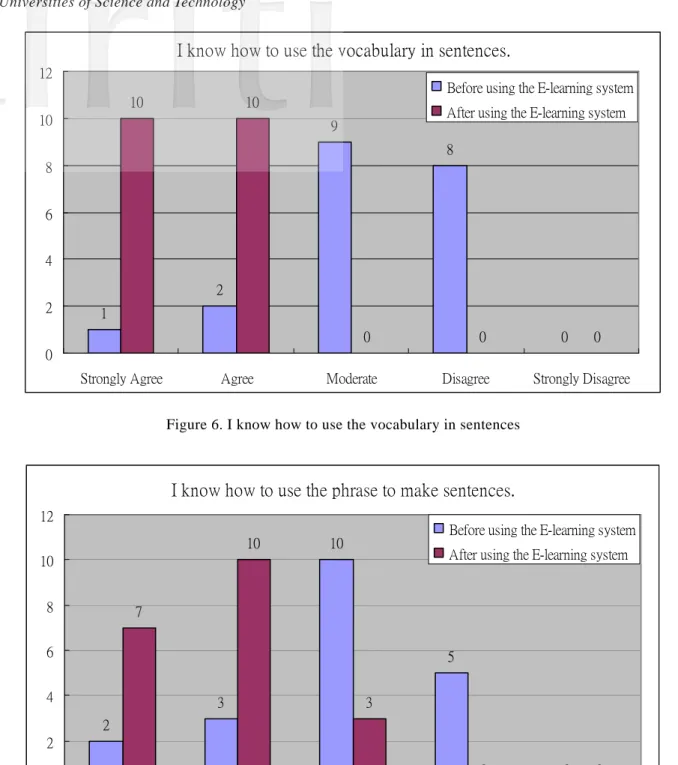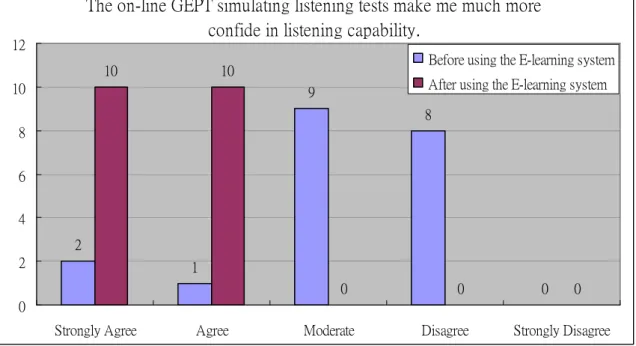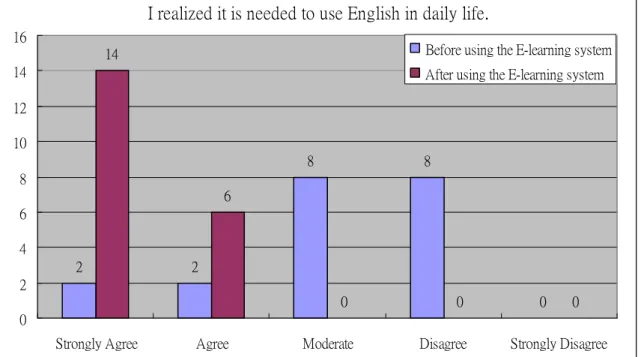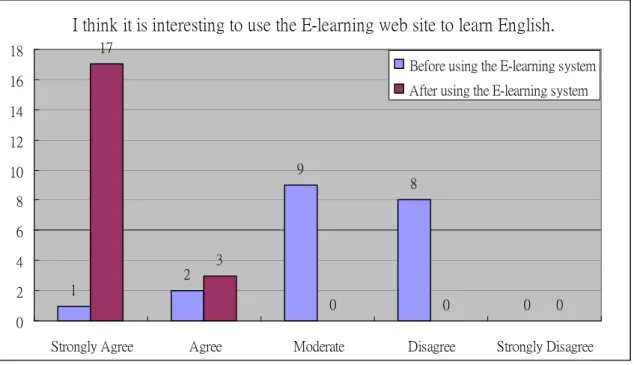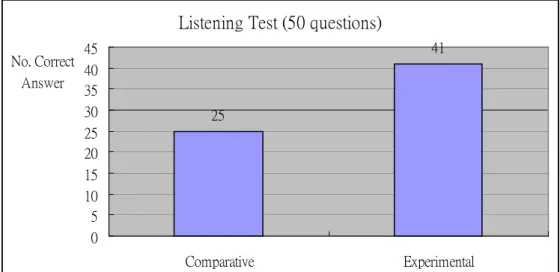Abstract
Most of the students in universities of science and technology are English underachievers. To increase learning motivation and provide students with an after-school self-learning environment, an English E-learning web site must be established as a remedial teaching aid. Previous studies have shown that students have very positive views of online learning websites.
E-learning web site can combine multimedia technology and allow users to review and practice the material at any place. Consequently, this research developed an English E-learning web site and investigated how it could benefit the English underachievers.
The results show that English underachievers can enhance their abilities with regard to vocabulary, phrases and listening by using the E-learning web site as a remedial teaching aid after school. The web site was also an inspiration to the underachievers, and encouraged them to have more interest in learning English.
Keywords: Underachiever, E-learning, Web Implementation, Remedial Teaching.
1. Introduction
Most of vocational university students have low levels of English proficiency, and these students have very little desire to study English. Many universities of science and technology measure students’ English levels during the first week of their freshman year. For example, Chung-Hwa University of Medical Technology (HWAI) divides students’ English degree into three groups: A (the best), B, and C, and then teaches them in accordance with these levels.
No matter which groups the students belongs to, they are not very willing to interact in their studies because they lack the necessary confidence. Consequently many of them fail to develop their abilities, or to pass the required English exams.
In order to increase students’ confidence and strengthen their ability to study independently, we establish an E-learning web site by classifying English teaching materials into appropriate levels. The underachievers can learn vocabulary, sentence patterns, and phrases through the web site, and undertake enjoyable self-study after class, thus gaining confidence in learning English. The high-level students can also learn more advanced English by using the simulated GEPT test provided by the web site.
Zhuang [1] examined the information technology and English education, and found that with advanced network information technology English study has evolved from the traditional classroom to forms based on interactive computer network. There are also remarkable differences in learning motivation, satisfaction and the study achievements between classroom-based learner and computer network based English learners. Chen [2] ©2007 National Kaohsiung University of Applied Sciences, ISSN 1813-3851
studied how the adoption of computer-aided narration can affect the learning effectiveness of an interactive English program, and found that such approaches significantly improved the learning effectiveness of English learners, and that regardless of the learner’s English proficiency there was greater improvement while learning short rather than learning in long dialogue.
Hsu [3] examined web-based courseware for freshman English conversation, and found that the traditional language instruction has been transformed by new approaches assisted by multimedia, computers, and network technology. The participation of numerous technologies makes a huge innovation to the traditional English conversation learning which was focused on reading and memorizing.
Chiu [4] examined the effects of CALL (computer-assisted language learning) and listening strategies on listening comprehension among EFL (English as foreign language) learners. She concluded that language teachers should provide students with listening strategies to enhance their listening comprehension, encourage less proficient students to actively employ such strategies, and integrate CALL in the English curriculum to enhance students’ listening strategy use and listening comprehension.
The effect of online materials on EFL college students' development of listening comprehension was investigated by Luo [5], who showed that advanced computer technology and the advent of the Internet have made the learning of listening more accessible and flexible in recent years. The online materials and multimedia CD-ROM could serve as alternative instructional materials, and learners have very positive views of online listening materials and listening websites.
The effects of CALL on EFL college students’ learning of verb-noun collocations were investigated by Chan [6]. She found that a web-based collocation instruction module is able to assist EFL college students’ collocation acquisition, and that such an approach was popular with students. In sum, the previous studies indicated that the adoption of E-learning web sites can definitely enhance the learning effectiveness of English, and promote the learners’ motivation and confidence.
2. Investigation Method
First, an E-learning web site was established by classifying English teaching materials. The participants for this study were forty C level students from the Management Information Department of HWAI University. Participants were assigned to one experimental group and one comparative group, with 20 students in each. The two groups both received traditional lessons in the class, and the experimental group students were also able to access the E-learning web site to review and practice online after school. The main goals of this study are to find out:
1. The differences between the two groups in vocabulary comprehension and memorization. 2. The differences between the two groups in phrase comprehension and memorization. 3. The differences between the two groups in listening comprehension and memorization.
4. The differences between traditional lessons and using the E-learning web site as a remedial teaching aid for English underachievers.
5. The relationship between user’s satisfaction with using E-learning web site and study achievements.
2.1 Establishment of the E-learning web site as a remedial teaching aid: Fig. 1 shows the flow chart for developing and testing the E-learning web site.
Figure 1. Flow chart for the development and testing of the E-learning web site
2.2 Experimental group learning process with the E-learning web site
The students can choose the learning materials, such as sentence patterns, phrases, and idioms from the E-learning web site in accordance with their English levels. Students can also share their learning experiences or undertake a discussion with the teacher and classmates through the web site. The detailed flow chart of the learning web site is presented in Fig. 2.
Figure 2. The flow chart of the learning web site
2.3 Simulated GEPT test
The simulated GEPT test included questions on vocabulary, grammar, phrases, idioms and listening. After the experimental group students used the web site, both groups students took the tests four times. We then analyzed the test results for both groups, paying attention to the differences.
3. Results
1. Establish the E-learning web site: this includes the analysis of the web site system, deciding the web site’s functions, establishing of E-learning web site’s learning procedure, collecting and establishing the teaching resources, and making the web pages interface.
2. The fundamental GEPT simulated test: this includes establishing the GEPT questions and testing web pages. 3. The E-learning web site:
Fig. 3(a): Using JavaScript and audio to build the on-line KK phonetics learning site which provides pronunciation samples for users to practice.
Fig. 3(b): Using JavaScript to allow students to get answers in real time for sentence pattern practice and providing an American teacher’s pronunciation for sentence pattern examples.
Fig. 3(c): Song teaching web pages, including lyrics to provide an alternative learning method.
Fig. 3(d): On-line GEPT simulated listening tests allow the students to practice their listening which is the most difficult part of English learning for Taiwanese students.
(a) (b)
(c) (d)
Figure 3. The E-learning web site: (a) KK Phonetics learning; (b) getting answers in real time; (c) song teaching web page; (d) on-line GEPT simulated listening tests.
4. Questionnaire and Discussion
4.1 QuestionnaireThe experimental group students filled out the questionnaire before and after using the E-learning system, with the results shown in Tables 1 and 2, and Figures 4 to 13.
1. From the two tables and Fig. 4, we know that only five students (25%) were aware of using KK phonetics to learn pronunciation before using the E-learning system, while after using the system eighteen students (90%) knew how to use this method to memorize vocabulary.
2. In Fig. 6, the number of the experimental students knowing how to use the vocabulary in sentences increased from 3 to 20 which were 15% and 100%, before and after using the system, respectively. This means that using JavaScript to allow students to get answers in real time for sentence pattern practice can enhance the students’ sentence-making capability.
3. The improvement in listening can be seen in Fig. 9, as all the participants gained much more confidence in this ability. The result show that it was the song teaching web pages and on-line GEPT simulated listening tests that caused this improvement.
Fig. 13, up from 15% to 100%, and all the experimental group students thought that it is interesting to use the web site to learn English.
Table 1 Before using the E-learning system Strongly
Agree Agree Moderate Disagree
Strongly Disagree I have learned to use the KK phonetics to
pronounce and memorize the vocabulary easily.
2 3 10 5 0
I know many ways to use the vocabulary
I have learned. 1 2 9 8 0
I know how to use the vocabulary in
sentences. 1 2 9 8 0
I know how to use phrases to make
sentences. 2 3 10 5 0
Using the song teaching web pages makes me memorize vocabulary more
easily.
3 3 8 6 0
The on-line GEPT simulated listening tests give me more confidence in
listening capability.
2 1 9 8 0
I realize it is necessary to practice
English everyday. 1 1 10 8 0
I realize it necessary to use English in
daily life. 2 2 8 8 0
I know how to learn English through this
E-learning web site. 1 1 9 9 0
I think it is interesting to use this
E-learning web site to learn English. 1 2 9 8 0
Table 2 After using the E-learning system Strongly
Agree Agree Moderate Disagree
Strongly Disagree I have learned to use the KK phonetics to
pronounce and memorize the vocabulary easily.
8 10 2 0 0
I know many ways to use the vocabulary I
have learned. 17 3 0 0 0
I know how to use the vocabulary in
sentences. 10 10 0 0 0
I know how to use phrases to make
sentences. 7 10 3 0 0
Using the song teaching web pages makes
me memorize vocabulary more easily. 15 5 0 0 0
The on-line GEPT simulated listening tests give me more confidence in listening
capability.
10 10 0 0 0
I realize it is necessary to practice English
everyday. 16 4 0 0 0
I realize it necessary to use English in
daily life. 14 6 0 0 0
I know how to learn English through this
E-learning web site. 19 1 0 0 0
I think it is interesting to use this
2 3 5 0 2 0 0 0 2 4 6
Strongly Agree Agree Moderate Disagree Strongly Disagree
Figure 4. I have learned use the KK Phonetics to pronounce and memorize the vocabulary easily
I know many ways to use the vocabulary I have learned.
1 2 9 8 0 17 3 0 0 0 0 2 4 6 8 10 12 14 16 18
Strongly Agree Agree Moderate Disagree Strongly Disagree Before using the E-learning system After using the E-learning system
I know how to use the vocabulary in sentences.
1 2 9 8 0 10 10 0 0 0 0 2 4 6 8 10 12Strongly Agree Agree Moderate Disagree Strongly Disagree Before using the E-learning system After using the E-learning system
Figure 6. I know how to use the vocabulary in sentences
I know how to use the phrase to make sentences.
2 3 10 5 0 7 10 3 0 0 0 2 4 6 8 10 12
Strongly Agree Agree Moderate Disagree Strongly Disagree Before using the E-learning system After using the E-learning system
3 3 6 0 5 0 0 0 0 2 4 6
Strongly Agree Agree Moderate Disagree Strongly Disagree
Figure 8. Using the Song teaching web pages make me easier to memorize vocabulary
The on-line GEPT simulating listening tests make me much more
confide in listening capability.
2 1 9 8 0 10 10 0 0 0 0 2 4 6 8 10 12
Strongly Agree Agree Moderate Disagree Strongly Disagree Before using the E-learning system After using the E-learning system
I realized it is necessary to practice English everyday.
1 1 10 8 0 16 4 0 0 0 0 2 4 6 8 10 12 14 16 18Strongly Agree Agree Moderate Disagree Strongly Disagree Before using the E-learning system After using the E-learning system
Figure 10. I realized it is necessary to practice English everyday
I realized it is needed to use English in daily life.
2 2 8 8 0 14 6 0 0 0 0 2 4 6 8 10 12 14 16
Strongly Agree Agree Moderate Disagree Strongly Disagree Before using the E-learning system After using the E-learning system
1 1 0 1 0 0 0 0 2 4 6 8
Strongly Agree Agree Moderate Disagree Strongly Disagree
Figure 12. I know the way to learn English through the E-learning web site
I think it is interesting to use the E-learning web site to learn English.
1 2 9 8 0 17 3 0 0 0 0 2 4 6 8 10 12 14 16 18
Strongly Agree Agree Moderate Disagree Strongly Disagree Before using the E-learning system After using the E-learning system
Figure 13. I think it is interesting to use the E-learning web site to learn English
4.2 Test
Figures 14 to 16 show the results of the listening, vocabulary and sentence tests. The comparative group participants only received the traditional classroom lessons while the experimental group also used the E-learning system. The two groups of students took the three kinds of tests after fifteen weeks’ instruction.
1. There were fifty questions in the listening test, and both groups took this test three times. The results can be seen in Fig. 14, which shows that comparative group got twenty-five questions right on average, while the
experimental group got forty-one correct, about a 32% difference. The main reason for this difference is that the experimental group’s students accessed the English song teaching web pages, story listening practice pages and GEPT listening simulated test pages repeatedly.
2. Fig. 15 shows the results for the vocabulary test, with twenty-eight questions correct for the comparative and forty-two for the experimental group, a difference of about 28%. The KK phonetics learning, sentence pattern practice, song teaching web pages, including the lyrics web pages, caused the different outcomes.
3. Fig. 16 presents the results for the sentence and phrase test and the average scores for comparative and experimental group are twenty-seven and forty-five, respectively, giving a difference of 36%. With the efficient vocabulary practice plus the sentence pattern web pages on the E-learning system, these results were not surprising.
Listening Test (50 questions)
25 41 0 5 10 15 20 25 30 35 40 45 Comparative Experimental No. Correct Answer
Figure 14. Listening Test (50 questions)
Vocabulary Test (50 questions)
28 42 0 5 10 15 20 25 30 35 40 45 Comparative Experimental No. Correct Answer
0 5 10
Comparative Experimental
Figure 16. Sentence Test (50 questions)
4.3 Discussion
After the on-line practice, the students memorized more words by learning songs, reading funny articles and listening to stories. They saw great improvements in their listening capability and understood more details in the listen content. The on-line material also allowed native speaker teachers to record standard pronunciation, and the JavaScript can allow student to use the mouse to find the right answer automatically. In this way, the students improved significantly in their understanding of sentences via the practice of on-line listening and real time translation. Most of the students had a very positive learning attitude and understood the benefits of the on-line learning.
From the above analysis, we can clearly know that the E-learning system not only improved the students’ English capabilities, including with regard to vocabulary, sentence making, phrase usage and listening, but also raised their test scores. Finally, the system also can encourage students to use English in daily life.
5. Conclusions
In general in Taiwan, the English language capabilities of technology university students are not very high. However, this work has shown that an E-learning web site can be used to address this situation. The results of using the system were as follows:
1. Better results in the listening exam.
2. Better results in the vocabulary or spelling exam. 3. Better results in the sentence-making exam.
4. A more open attitude with regard to learning from such web sites.
Figure 14 shows that the on-line listening training material is helpful to improve the student’s listening capability. Fig. 15 shows the improvement in vocabulary learning. Fig. 16 shows the improvement in sentence learning.
From Figures 4 to Fig 13, we can tell that the students are satisfied with the online learning system. Although these students may not have good English abilities and also lack motivation. We can still try to help them by providing an E-learning system.
References
[1] Zhuang, Y. F., “The influence of Network's learning environment to adult English learning,” master's thesis, Yuan Ze University, 2001.
[2] Chen, Y., “The Study of the Adoption of Computer-Aided Narration Affecting the Learning Effectiveness of Interactive English Program — ‘Go2School’ Online Curriculum as an Example,” master's thesis, Chinese Culture University, 2005. [3] Hsu, C. C., “Development of Web-based Courseware for Freshman English Conversation,” master's thesis, Tamkang
University, 2002.
[4] Chiu, H. W., “The Effects of CALL and Listening Strategies on Listening Comprehension among EFL Learners,” master's thesis, Dayeh University, 2006.
[5] Luo, H. Y., “A Study of Online Materials on EFL College Students' Development of Listening Comprehension,” master's thesis, National Tsing Hua University, 2006.
[6] Chan, T. P., “Effects of CALL Approaches on EFL College Students’ Learning of Verb-Noun Collocations,” master's thesis, National Tsing Hua University, 2003.
[7] Wang, C. W., “CALL Courseware Development and Vocabulary Annotations,” master's thesis, National Tsing Hua University, 2001.
[8] Chen, Y. S. “A Prototype Study of Computer-Assisted-Instruction Design on Vocabulary Learning: A Contextual Approach,” master's thesis, Fu Jen Catholic University, 1993.
[9] Lee, M. I., “The Effects of English Songs in Multimedia-Based System on Motivation and Achievement of Elementary Students,” master's thesis, National Pingtung University of Education, 2004.
[10] Wang, M. C., “A Case Study on Multimedia in TEFL,” master's thesis, National Kaohsiung Normal University, 2003. [11] Wang, H. L., “The Effect of Using the Computer-Assisted Instruction as Remedial Teaching on Junior High English
Underachievers,” master's thesis, National Kaohsiung Normal University, 2003.
[12] Lee, Y. C., “A Comparison Study between Multimedia Test Items and Text-based Test Items Based on Primary School English Curriculum,” master's thesis, National Chiao Tung University, 2004.
[13] Yeh, F. J., “The action-research of multi-media use in English teaching,” master's thesis, National Dong Hwa University, 2004.
[14] Cheng, W. W., “Learner Perspectives of Self-Access in the Multimedia English Learning Center at NKFUST,” master's thesis, National Kaohsiung First University of Science and Technology, 2005.
[15] Huang, S., “A study on the multi-media application in English co-operative learning of 5th graders at elementary schools,” master's thesis, National Chiayi University, 1992.
[16] Beccue, B., Vila J. and Whitley, L., “The Effects of Adding Audio Instructions to a Multimedia Computer Based Training Environment,” Journal of Educational Multimedia and Hypermedia, Vol. 10, pp. 47-67, 2001.
[17] Kalyuga, S., Chandler, P. and Sweller, J. “Incorporating Learner Experience Into the Design of Multimedia Instruction,” Journal of Educational Psychology, Vol. 92, pp. 126-136, 2000.
[18] William, B., “Effects of learner control and hypermedia preference on cyber-students performance in a Web-based learning environment,” Journal of Educational Multimedia and Hypermedia, Vol. 11, pp. 71-91, 2002.
[19] Bagui, K., “Reasons for increased learning using multimedia,” Journal of Educational Multimedia and Hypermedia, Vol. 7, pp. 3-18, 1998.
[20] GEPT Web Site, http://www.gept.org.tw, 2009.
[21] The Language Training and Testing Center, http://www.lttc.ntu.edu.tw, 2009. [22] TOEIC Test Center, http://www.toeic.com.tw, 2009.

